Emerald Tree Monitor
- March 11, 2024
- 0 comment
Emerald Tree Monitors, scientifically known as Varanus prasinus, are fascinating arboreal reptiles native to the rainforests of New Guinea and nearby islands. Renowned for their striking emerald-green coloration, these creatures possess sleek bodies adorned with glossy scales, blending seamlessly into their lush canopy habitat. They exhibit remarkable agility, navigating the treetops with the aid of their sharp claws and prehensile tails. Despite their arboreal nature, Emerald Tree Monitors occasionally venture to the forest floor in search of prey or sunlight.

Their diet consists of a diverse array of insects, small vertebrates, and occasionally fruits or nectar. These diurnal reptiles engage in intricate courtship rituals during the breeding season, with females laying a clutch of eggs concealed within their arboreal domain. While admired for their beauty, Emerald Tree Monitors present challenges as pets, requiring specialized care and spacious enclosures to thrive. Conservation efforts are crucial to safeguarding these enchanting creatures from threats such as habitat destruction and illegal trade, ensuring their continued presence in the tropical rainforest ecosystem.
| Specification | Description |
|---|---|
| Scientific Name | Varanus prasinus |
| Common Name | Emerald Tree Monitor |
| Habitat | Rainforests and tropical woodlands of New Guinea |
| Geographic Distribution | New Guinea and nearby islands such as Salawati, Misool |
| Size | Adults typically 70-90 centimeters in length |
| Coloration | Vibrant emerald-green with occasional yellow or blue markings |
| Behavior | Primarily diurnal, adept climbers, occasionally descend to forest floor |
| Diet | Insects, small vertebrates, occasionally fruits or nectar |
| Reproduction | Females lay 3-5 eggs, incubated for 2-3 months |
| Conservation Status | Near Threatened (IUCN) due to habitat destruction, illegal pet trade |
| Interaction with Humans | Challenging pets requiring specialized care and spacious enclosures |
| Notable Features | Regenerative tails, vocalizations, keen sense of smell |
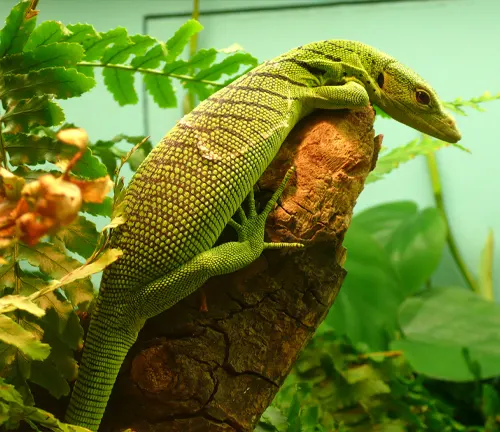
Emerald Tree Monitors, scientifically known as Varanus prasinus, are captivating creatures that inhabit the rainforests of New Guinea and nearby islands. These arboreal reptiles are renowned for their striking emerald-green coloration and agile climbing abilities. Let’s delve deeper into the world of Emerald Tree Monitors, exploring their physical characteristics, behavior, conservation status, and much more.
Physical Description
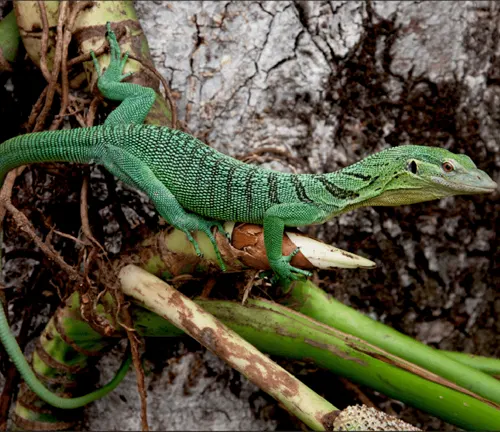
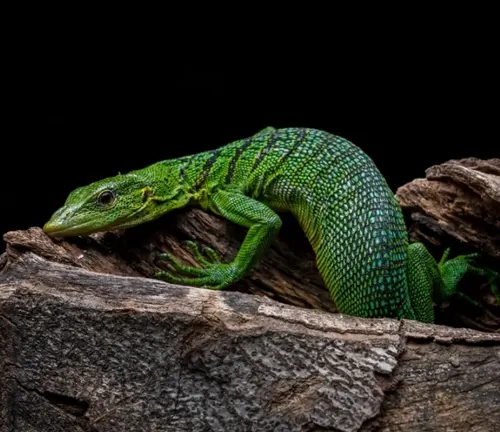
The physical description of the Emerald Tree Monitor encompasses its distinctive features and characteristics. These arboreal reptiles possess sleek, elongated bodies adorned with smooth, glossy scales. The most striking aspect of their appearance is their vibrant emerald-green coloration, which serves as effective camouflage amidst the lush foliage of their habitat. Occasionally, they may exhibit yellow or blue markings, adding to their visual allure. Typically, adults measure between 70 to 90 centimeters in length, with their long, prehensile tails comprising a significant portion of their overall size. Their slender limbs are equipped with sharp claws, facilitating adept climbing and gripping of branches as they navigate the treetops with remarkable agility. This physical adaptation allows them to thrive in their arboreal environment, where they spend the majority of their time hunting for prey or basking in the sunlight filtering through the canopy.
Habitat and Distribution


The habitat and distribution of the Emerald Tree Monitor are closely tied to the rainforests and tropical woodlands of New Guinea and nearby islands. These arboreal reptiles are predominantly found in dense, humid forests where they can utilize their climbing abilities to navigate the treetops with ease. While their primary range encompasses New Guinea, Emerald Tree Monitors have also been documented on nearby islands such as Salawati and Misool. Within their habitat, they occupy a variety of forest types, including lowland rainforests, montane forests, and even secondary growth forests. Their distribution within these habitats can vary based on factors such as elevation, vegetation density, and prey availability. Despite their relatively restricted geographic range, Emerald Tree Monitors have managed to adapt to various environmental conditions within their habitat, demonstrating their resilience as arboreal inhabitants of the tropical rainforest ecosystem.
Behavior and Lifestyle
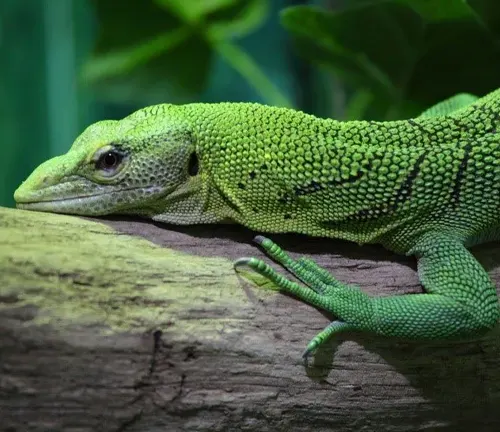
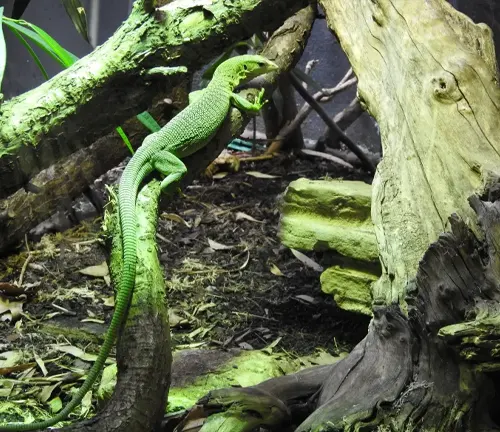
Emerald Tree Monitors exhibit fascinating behavior and lifestyles that are adapted to their arboreal habitat. Primarily diurnal creatures, they are most active during the daytime, utilizing the sunlight to warm themselves and forage for food. Their agile climbing abilities allow them to navigate the treetops with remarkable ease, using their sharp claws and prehensile tails for balance and grip. Despite their arboreal nature, Emerald Tree Monitors may occasionally descend to the forest floor in search of prey or to bask in the warmth of the ground.
In terms of hunting and feeding habits, these reptiles are opportunistic predators, preying on a variety of insects, small vertebrates, and occasionally fruits or nectar. They use their keen eyesight and sense of smell to locate potential prey items within the dense foliage of their habitat. Communication among Emerald Tree Monitors primarily occurs through a range of vocalizations, including hisses, chirps, and grunts, which they use to communicate with conspecifics or establish territories.
During the breeding season, male Emerald Tree Monitors engage in elaborate courtship rituals to attract potential mates. Mating typically occurs in the canopy, where females will later lay a clutch of eggs in a concealed nest, often located within tree hollows or dense vegetation. After an incubation period of approximately 2 to 3 months, the hatchlings emerge and begin their journey in the arboreal environment.
Reproduction
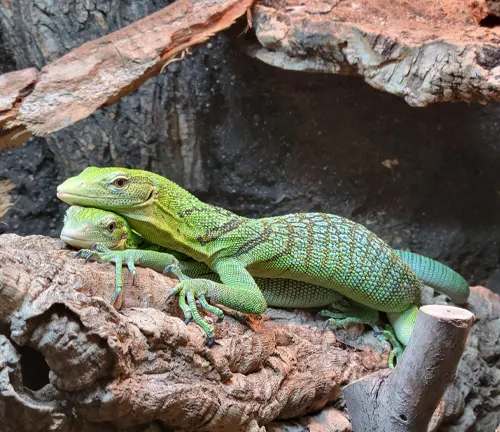

Reproduction in Emerald Tree Monitors involves a series of fascinating behaviors and processes that are essential for perpetuating their species. During the breeding season, which typically occurs in the warmer months, male Emerald Tree Monitors engage in elaborate courtship displays to attract potential mates. These displays often involve physical gestures, vocalizations, and scent marking to communicate their readiness to breed.
Once a female has been courted and accepts a mate, copulation takes place. Mating usually occurs in the canopy of the forest, where the male will mount the female to fertilize her eggs internally. Following fertilization, the female will seek out a suitable nesting site within her arboreal domain. Nests are typically constructed in hollow trees, dense vegetation, or other concealed locations that provide protection and security for the developing eggs.
After selecting a nesting site, the female will lay a clutch of eggs, typically numbering between 3 to 5 eggs, although clutch size can vary. The eggs are elongated and covered in a leathery shell, providing protection against damage and dehydration. Once laid, the female will carefully arrange the eggs within the nest and may remain nearby to guard them against potential predators.
The incubation period for Emerald Tree Monitor eggs lasts approximately 2 to 3 months, during which time the female may periodically check on the eggs and adjust their position as needed. Temperature and humidity levels within the nest play a crucial role in determining the development and hatching success of the eggs.
Conservation Status
The conservation status of Emerald Tree Monitors is a topic of concern due to various threats they face in their natural habitat. These threats include habitat destruction, primarily through deforestation and land conversion for agriculture or development. As rainforests continue to be cleared at an alarming rate, the Emerald Tree Monitor’s habitat diminishes, leading to population declines and fragmentation.
Another significant threat to Emerald Tree Monitors is the illegal pet trade. These captivating reptiles are sought after by collectors and enthusiasts, leading to poaching and smuggling from their native range. The removal of individuals from the wild for the pet trade not only impacts wild populations but also disrupts their ecological roles within the ecosystem.
Additionally, Emerald Tree Monitors are vulnerable to predation by introduced species such as feral cats and dogs, which can decimate populations of native wildlife, including these reptiles.
In response to these threats, various conservation efforts are underway to protect Emerald Tree Monitors and their habitats. These efforts include establishing protected areas, implementing laws and regulations to prohibit the illegal trade and exploitation of these reptiles, and conducting research to better understand their ecology and conservation needs.
Interaction with Humans
The interaction between Emerald Tree Monitors and humans can take various forms, ranging from their role as subjects of scientific study to their presence in the pet trade and captivity.
In their natural habitat, Emerald Tree Monitors may have limited direct interaction with humans due to their arboreal lifestyle and the remote locations they inhabit. However, they are occasionally encountered by researchers and wildlife enthusiasts exploring the rainforests of New Guinea and nearby islands. These encounters provide opportunities for observation and study, contributing to our understanding of their behavior, ecology, and conservation needs.
In captivity, Emerald Tree Monitors are sometimes kept as exotic pets by reptile enthusiasts. However, their specialized care requirements and delicate temperament make them challenging pets to maintain. Responsible ownership entails providing spacious enclosures with ample climbing opportunities, maintaining optimal humidity levels, and offering a diverse diet to meet their nutritional needs. Interactions with captive Emerald Tree Monitors should prioritize their welfare and well-being, avoiding unnecessary stress or handling.
Interesting Facts
- Emerald Tree Monitors possess a remarkable ability to regenerate lost tails, a defense mechanism against predators.
- They communicate through a range of vocalizations, including hisses, chirps, and grunts.
- Their keen sense of smell enables them to locate prey hidden among the foliage with remarkable precision.
Myths and Misconceptions
- Venomous Nature: One common misconception about Emerald Tree Monitors is that they are venomous. In reality, these reptiles do not possess venom glands or venomous fangs, relying instead on agility and camouflage for defense.
- Aggressiveness: Another misconception is that Emerald Tree Monitors are aggressive animals. While they may exhibit defensive behaviors if threatened, they are generally shy and will prefer to flee rather than confront humans or other potential threats.
- Difficulty in Care: Some people believe that Emerald Tree Monitors are easy to care for as pets. However, due to their specialized habitat and dietary requirements, they actually require experienced caretakers and meticulous attention to their husbandry needs.
- Poor Health: There is a misconception that Emerald Tree Monitors are prone to health issues in captivity. While they can be sensitive to improper husbandry conditions, with proper care, they can thrive and live long, healthy lives in captivity.
Significance in Ecosystem
- Predator Control: Emerald Tree Monitors play a vital role in controlling insect populations within their habitat. As apex predators, they help regulate populations of insects and small vertebrates, contributing to the overall balance of the ecosystem.
- Seed Dispersal: Like many arboreal species, Emerald Tree Monitors may inadvertently aid in seed dispersal through their movements and feeding habits. By consuming fruits and moving through the canopy, they help disperse seeds to new areas, promoting the growth and diversity of plant species.
- Indicator Species: The presence or absence of Emerald Tree Monitors can serve as an indicator of the health of their habitat. Monitoring populations of these reptiles can provide valuable insights into the overall health and stability of the rainforest ecosystem.
- Tourism and Education: Emerald Tree Monitors can also have significance in ecotourism and environmental education efforts. Their captivating appearance and behavior attract tourists and researchers to rainforest areas, where they can learn about the importance of conservation and biodiversity.
Different Species
Varanus beccarii
(Black Tree Monitor)
Found in New Guinea, this species is closely related to Varanus prasinus and shares its arboreal habits and emerald-green coloration.
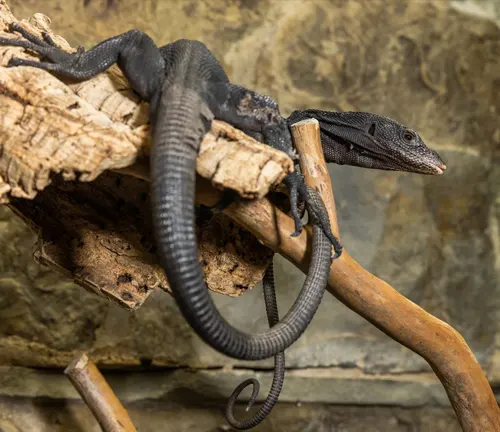

Varanus boehmei
(Green Tree Monitor)
Native to the Aru Islands in Indonesia, this species exhibits a vibrant green coloration similar to Varanus prasinus, although it may have slight variations in appearance.
Varanus keithhornei
(Kei Island Emerald Monitor)
Endemic to the Kei Islands in Indonesia, this species is known for its striking emerald-green coloration and arboreal lifestyle, resembling other Emerald Tree Monitors.
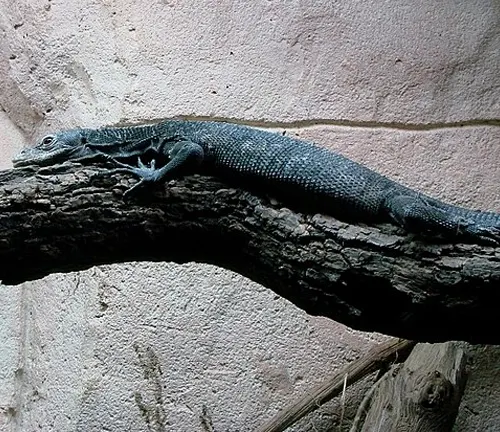
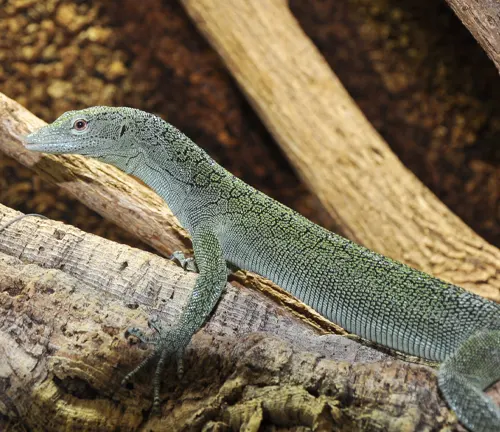
Varanus kordensis
(Kordensis Tree Monitor)
Found in the Kordofan region of Sudan, this species is not closely related to the Emerald Tree Monitors of the Varanus genus, but it may be referred to as an “Emerald Tree Monitor” due to its green coloration.
Frequently Asked Questions (FAQs)
- How big do Emerald Tree Monitors grow?
Adult Emerald Tree Monitors typically reach lengths of 70 to 90 centimeters, including their tails. - Do Emerald Tree Monitors require special enclosures in captivity?
Yes, Emerald Tree Monitors need spacious enclosures with ample climbing opportunities, appropriate temperature gradients, and humidity levels. - Are Emerald Tree Monitors endangered?
While not classified as endangered, Emerald Tree Monitors are listed as Near Threatened due to habitat destruction and illegal pet trade. - Can Emerald Tree Monitors be housed together?
While they may tolerate conspecifics in large enclosures, Emerald Tree Monitors are typically solitary animals and may exhibit aggression towards each other. - How do I provide proper heating for my Emerald Tree Monitor enclosure?
Using basking lamps and heat emitters, you can create temperature gradients within the enclosure to mimic their natural habitat. - Do Emerald Tree Monitors require UVB lighting?
Yes, UVB lighting is essential for Emerald Tree Monitors to metabolize calcium and maintain proper bone health. - How often should I feed my Emerald Tree Monitor?
Juveniles may require feeding every day, while adults can be fed every 2-3 days, with a varied diet consisting of insects, small rodents, and occasional fruits or vegetables. - Do Emerald Tree Monitors enjoy being handled?
Emerald Tree Monitors are generally not fond of handling and may become stressed if handled excessively. It’s best to limit handling to essential care tasks. - What should I do if my Emerald Tree Monitor refuses to eat?
Monitor their behavior closely and ensure that environmental conditions such as temperature and humidity are optimal. Consult a reptile veterinarian if feeding issues persist. - Can Emerald Tree Monitors be housed with other reptiles or pets?
It’s generally not recommended to cohabitate Emerald Tree Monitors with other reptiles or pets due to potential aggression or stress. It’s best to provide solitary housing.


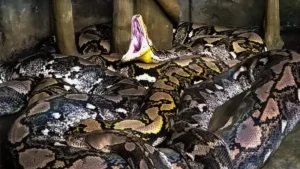
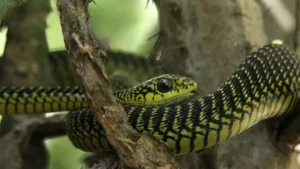
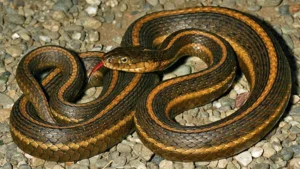
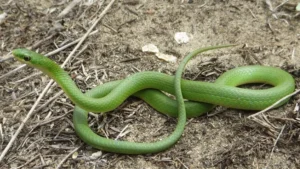








Leave your comment